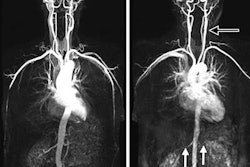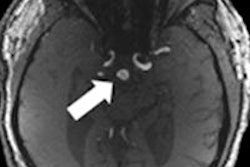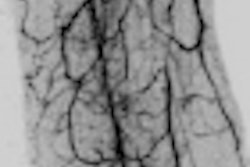MR angiography (MRA) using a 3D time-of-flight (TOF) sequence could well be the most efficient technique for detecting unruptured cerebral aneurysms (UCAs) and determining if they pose a health risk, according to a study published in the October 15 issue of Annals of Internal Medicine.
Using 3D TOF MRA, Chinese researchers found unruptured cerebral aneurysms in 7% of adults between the ages of 35 and 75 years, but only 8.7% of the aneurysms were thought to be at risk for rupture based on their size, shape, and location.
By better characterizing which aneurysms pose a threat, physicians could prescribe appropriate therapy and image a patient on a regular basis to help prevent a rupture, concluded lead author Dr. Ming-Hua Li, PhD, from Fudan University's School of Public Health, and colleagues (Ann Intern Med, October 15, 2013, Vol. 159:8, pp. 514-521).
Undetected aneurysms
Li and colleagues noted that the interest in detecting unruptured cerebral aneurysms has increased in recent years, given that ruptured aneurysms can have grave consequences.
The aneurysms are most commonly detected using digital subtraction angiography (DSA), CT angiography, and/or MR angiography. However, MRA is "ideal" for the general population, according to the authors, as CT angiography requires contrast agents and exposes patients to radiation. In addition, previous DSA studies tended to overestimate the presence of UCAs because they had a greater percentage of patients with suspected cerebral vascular disease.
The researchers surveyed UCAs in adults ages 35 to 75 at their Shanghai facility between June 2007 and June 2011. Potential subjects were excluded if they had a pacemaker, metallic or dental implants, a false eye, or a bionic ear. Pregnant or claustrophobic individuals were also excluded.
A total of 4,813 subjects (2,368 men and 2,445 women) with a median age of 53 years qualified for the study. The cohort was divided into four age categories: 35 to 44 years, 45 to 54 years, 55 to 64 years, and 65 to 75 years.
Participants completed a questionnaire that included demographic information, personal and family medical history, and lifestyle risk factors such as smoking habits and alcohol consumption. All subjects underwent 3D time-of-flight MR angiograms on a 3-tesla MRI system (Achieva, Philips Healthcare) using T1-weighted fast-field MR sequences.
Li and colleagues defined UCAs as an abnormal focal dilatation of a cerebral artery with attenuation of the vessel wall or an enlargement with a maximum diameter greater than 3 mm. Only UCAs with a diameter of at least 2 mm were included in the study. Three observers, who were blinded to the patients' information, independently evaluated the 3D TOF MRA exams.
Aneurysm prevalence
A total of 369 aneurysms were detected in 336 participants; 130 men (2.7%) and 206 women (4.3%) had UCAs, according to the MRA results. The other 4,477 participants (93%) did not have UCAs.
The prevalence of UCAs increased significantly as participant age increased, peaking in the 55- to 64-year age group, Li and colleagues found.
Twenty-seven participants (8%) had several aneurysms, with one person having five UCAs. Three individuals had three UCAs each, 23 had two each, and 309 had one each.
The most common location for UCAs was the internal carotid artery, where 299 aneurysms (81%) were found. There were 46 aneurysms (12%) in the anterior cerebral artery, including 40 (11%) in the anterior communicating artery.
As for the potential health risk to the individuals, 336 aneurysms (91.1%) were regular, while 32 (8.7%) were irregular or had a maximum diameter of at least 7 mm, with the potential for rupture. One aneurysm (0.2%) was fusiform, or elongated, and likely not a threat.
"Prophylactic therapy and regular imaging surveillance, if adequately administered, may help prevent rupture" of the irregular aneurysms, Li and colleagues wrote.
Risk factors
Of the 369 aneurysms, 333 (90%) were less than 5 mm in size; the mean maximum diameter of the aneurysm sac was 3.5 mm (range, 2.0 to 21.2 mm). The mean diameter was larger in women (3.7 mm) than in men (3.2 mm).
One interesting observation was that the 7% prevalence of UCAs in adults 35 to 75 years of age was greater than percentages reported in previous studies. Li and colleagues attributed the increase to the "use of high-quality MRA at 3.0 [tesla], which has been shown to have high accuracy and sensitivity for detection of cerebral aneurysms."
In addition, while a large proportion of study participants reported a history of hypertension and cardiovascular disease, the associations between these risk factors and the prevalence of aneurysms were not statistically significant.
"Because this cross-sectional study mainly focused on the prevalence of UCAs, the association between the aforementioned risk factors and development of UCAs in Chinese adults needs exploration in additional, longitudinal studies," the authors added.
They noted various study limitations, including the cross-sectional nature of the study and the fact that adults older than 75 were not included.
"Because the survey was conducted in two communities from two districts in Shanghai and adults older than 75 years were not studied, the findings may not be applicable to the general population," Li and colleagues wrote.



















